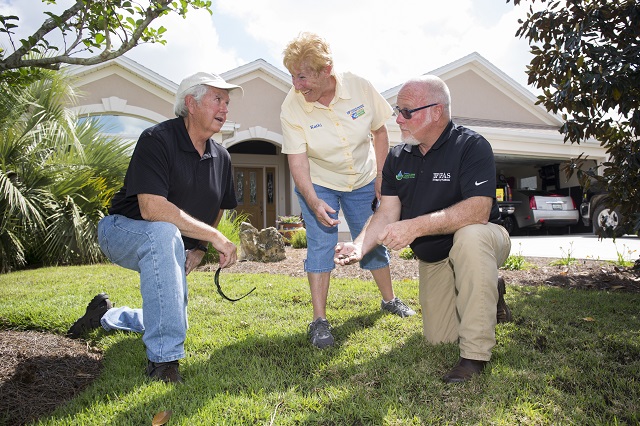Every day over 900 people move to Florida. Last December, my wife, my son, and I became three of those people. Like most new residents, we were drawn to Florida’s natural beauty, and we’ve also spent a lot of time driving through neighborhoods, looking at homes, comparing, planning, and dreaming. After a lot of careful consideration, we decided to build a house.
Now, because of my long experience in environmental science, not to mention my new position as dean of UF/IFAS Extension, I—we—wanted to do this right. I was acutely aware of the science that Florida’s population will grow by 50 percent over the next 50 years, and the enormous strain this will put on our natural resources, environment, infrastructure, and land use. We were determined to be good new residents and not contribute to the problem of urban growth.
One of the first things I asked the builder was, “What are your landscape options?” When he mentioned Florida-Friendly Landscaping, I knew we’d made a good decision—about the new house and the new job.
Florida-Friendly LandscapingTM (FFL) is a UF/IFAS Extension program that educates homeowners, landscapers and developers about how to create and maintain beautiful landscapes with minimal impact on the environment. It presents an alternative to traditional Florida landscaping, which tends to showcase wide-open lawns of manicured turfgrass. We saw a lot of those while we were house-hunting. The problem with this traditional approach is that it requires frequent application of water, fertilizer and pesticides—all of which drain our natural resources and contribute to things like algal blooms and climate change.

FFL offers nine basic principles of landscape design and maintenance that anyone can implement to reduce water, fertilizer and pesticide inputs and grow your landscape in greater harmony with Florida’s natural environment.
The fact that the developer was telling me about Florida-Friendly landscaping is a sign that our work is making a difference, from the state to the local level.
I recently had the opportunity to speak at the 2022 Urban Landscape Summit. This annual event, hosted by the UF/IFAS Center for Land Use Efficiency, brings together researchers, students, Extension faculty and Florida’s green industry leaders to discuss the latest research and strategies for creating more sustainable urban environments. The level of collaboration, ingenuity and commitment I saw among these participants was inspiring.
From Tina McIntyre, I learned about fertilizer education workshops in Seminole County, which incentivize responsible fertilizer use by providing participants with a free bag of slow-release fertilizer and licensing CEUs for professional landscapers. She also shared PSAs that use humor and music to drive home the message about proper fertilizer use.
John Diaz talked about changing the perception that rainfall is a supplement to irrigation, not the other way around. One of the facts I learned from Nick Taylor of H2OSav is that a single-family home—our home—uses an average of 190 gallons of water per day. That’s equal to more than a full pallet of water bottles delivered to our door every day! More than 50 percent of that water goes to lawn irrigation. By using moisture sensors–or simply turning off the sprinklers when it’s about to rain—we can significantly reduce water use and head off the water crisis that will come as Florida’s population reaches 33 million by 2070.

Claire Lewis outlined an innovative turf-swap program in Hernando County. Homeowners in the Wellington community were experiencing a disease called “take-all root rot” in their St. Augustine grass. So, Claire and Hillsborough County agent Bill Lester joined forces with the Southwest Florida Water Management District to offer to replace the St. Augustine grass with Bahiagrass, which is less susceptible to root rot and also requires less water and fertilizer. The swap also included Florida-Friendly Landscaping plants and microirrigation sprinklers. Participants get a new lawn and lower utility bills; the community gets less water use and fewer chemicals leaching into the aquifer—a win-win.
Pierce Jones and Brooke Moffis reported on their work at the research base camp at Sunbridge, a 23,000-acre planned community in Osceola and Lake counties. Brooke is studying the resource efficiency of landscapes that blend turfgrass with native flowering plants such as salvia and mimosa. Pierce, with the Program for Resource Efficient Communities, is working with developers at Sunbridge to install soil amendments for landscapes that require less water and fertilizer inputs.

These are just a few of the many projects UF/IFAS research, teaching and Extension are undertaking to help homeowners and landscapers plant greener landscapes in Florida. For a new homeowner like me, this is an exciting time to explore these methods and establish a home landscape that not only looks beautiful but works with the world that surrounds it.
At UF/IFAS Extension, we believe that a key solution to saving our planet lies right under our feet. By starting with a sustainable backyard, we can build a more sustainable world.
 0
0
